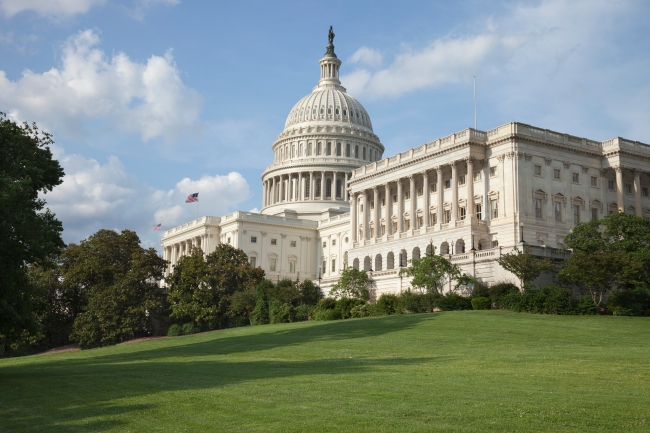You have /5 articles left.
Sign up for a free account or log in.

Getty Images
The deal reached by Congress this weekend on an omnibus budget for the current 2017 fiscal year included key victories for universities and higher ed advocates.
It also looked like at least a preliminary rejection of the draconian budget blueprint offered by the Trump administration for the next federal fiscal year.
The spending agreement, which funds the government through September, restores year-round Pell Grant funding, a longtime priority sought by student aid groups since its elimination as a cost-saving measure in 2011. The deal also funds the National Institutes of Health at $2 billion more than 2016 levels. And it provides modest increases to college readiness programs TRIO and GEAR UP, which were reduced significantly in the proposed White House 2018 budget plan.
Where higher ed groups didn't gain important, if modest, wins like year-round Pell -- a policy that has received bipartisan backing -- the budget agreement mostly maintained the status quo.
"This is a congressional rebuff of the administration's funding request," said Justin Draeger, president and CEO of the National Association of Student Financial Aid Administrators. "And it's an acknowledgment that realistically you can't slash budgets midyear."
Following the release in March of a "skinny budget" document that proposed drastic reductions to the NIH, as well as financial aid and college-readiness programs, the White House sent congressional budget writers instructions on how they should negotiate spending levels to fund the government past April 28, when a continuing resolution was set to expire. Those guidelines included significant cuts, especially for the Department of Education.
Kelly McManus, the director of legislative affairs at the Education Trust, said the agreement shows that lawmakers recognized that the kind of cuts to higher ed proposed by the administration were unacceptable.
"I would call it a pretty thorough repudiation of the administration's proposal," she said.
McManus said Ed Trust hopes the deal is indicative of how Congress will approach the fiscal year 2018 budget but said it would be incumbent upon advocates to keep the pressure on. Other higher ed observers weren't necessarily quick to assume the funding deal reached this weekend will signal positive things about future negotiations.
"It's tempting to draw conclusions from this year's budget about next year. But we live in a fragile and fast-changing political world," said Terry Hartle, senior vice president of government and public affairs at the American Council on Education. "I think making assumptions about how things will play out four months down the road are very risky."
Clare McCann, a senior policy analyst with New America's Education Policy program, said Congress doesn't appear to have an interest in pursuing the drastic cuts outlined by the White House, especially outside of a reauthorization of the Higher Education Act.
"For the most part, the Trump budget will likely be a messaging document," she said. "Congress will likely continue with business as usual."
McCann said lawmakers restored year-round Pell eligibility in a responsible way by capping students at 150 percent of a maximum Pell Grant in a single year. That means they'll have roughly the same amount between fall, spring and summer semesters. It also helps ensure that students do not quickly exhaust their lifetime Pell eligibility, which is capped at 12 semesters, before they can make serious progress toward a degree.
To pay for restored year-round eligibility, the deal takes about $1.3 billion from the $10 billion Pell surplus.
Beth Akers, a senior fellow at the Manhattan Institute, said the policy change reflects the fact that the college-going population is increasingly made up of students who don't necessarily attend a university full-time and graduate in four years.
"It realigns the financial aid system with the reality of today's students," Akers said.
The $22.5 billion included for Pell Grants in the spending package, combined with mandatory funding, will also allow the maximum size of the grant to rise modestly by $105, to $5,920.
Mary Clare Reim, a policy analyst at the Heritage Foundation who focuses on higher education, said the group supports the added flexibility of year-round Pell if it helps students to graduate college and enter the work force faster. But Heritage opposes increasing the maximum size of the grant.
"Our fear is that we've been expanding Pell Grants more and more and these are possibly going to students who would have other options to finance college," she said.
That view is at odds with even some on the right. But advocates for student aid say there is still serious work to be done on Pell even after year-round eligibility is restored. Lauren Asher, president of the Institute for College Access and Success, said in a statement that the budget agreement preserves already scheduled increases in the value of the grant based on inflation. But she said the value of the grant will decrease in real terms in 2018 unless Congress takes action.
"With college costs so out of reach for low-income families, we urge Congress to use the Pell Grant reserve funds -- the results of prior program cuts and an improving economy -- to protect and strengthen resources for college affordability, not raid Pell Grant funding to spend elsewhere," Asher said.
The omnibus package was also notable for what got left out. Republican lawmakers were unsuccessful in attempts to include budget riders that would defund Obama administration regulations including gainful employment. Democrats had said such policy riders would be "poison pills" that would block any budget resolution.
Reim said it was disappointing that there would not be any significant departure for the time being on those Obama-era policies. However, with control of the executive branch, Republicans have control over implementation of those rules.
Lawmakers agreed to provide more than $34 billion to the National Institutes of Health in the deal, another divergence from the Trump budget plan that makes 2017 the second consecutive year in which the agency would receive an increase of $2 billion. NIH is the largest federal supporter of research and development in the federal government and sends 80 percent of its funding to universities and research centers throughout the country in the form of grant awards.
"These increases follow a decade of reduced investments that constricted American medical innovation," said Peter McPherson, the president of the Association of Public and Land-grant Universities, in a statement. The omnibus bill, he said, "puts our country back on track for needed healthy and sustained federal investments in medical research."
Other research agencies important to university scientists, including the National Science Foundation and the Energy Department's research programs, would receive essentially flat funding.
Congress kept funding for Workforce Innovation and Opportunity Act job-training grants steady at $2.7 billion. And the budget deal increased funding for apprenticeship programs, which experts said is a signal that congressional Republicans share the Trump White House's stated interest in expanding that approach to job training. The bill continues funding to states and industry and other intermediaries to support that expansion, while also increasing the federal appropriation for apprenticeships to $95 million, an increase of $5 million.
"It's a real signal that the interest in apprenticeship won't die with the Obama administration," said Mary Alice McCarthy, director of the Center on Education and Skills with the education policy program at New America and a former official at the U.S. Education and Labor Departments.
The National Endowments for the Humanities and for the Arts would also see slight increases for the 2017 fiscal year, in sharp contrast to the eliminations that the Trump administration has proposed for 2018. The endowments would each receive $150 million for the rest of 2017, up from the $148 million they received in 2016.








